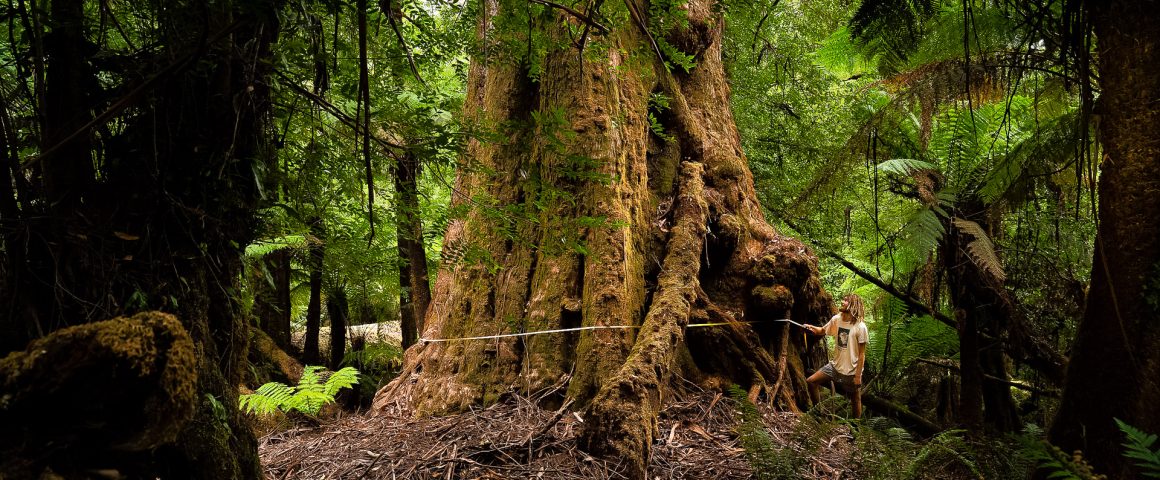FORESTRY WATCH
Science for the people; a fledgling grass-roots group holds Tasmanian loggers to account.
Words: James McCormack
Photography: Steve Pearce
(This story originally featured in Wild #177, Spring 2020)
Against all the gargantuan, industrial-scale machinery that is pillaging Tasmania’s native forests—the immense mechanical log loaders with their 10m reticulated grapplers, the mammoth dozers and excavators, the spidery cable loggers craning as high as eight-storey buildings—a simple hand-held tape measure may seem a strange tool with which to fight back, a veritable David against a horde of Goliaths. But over the last eight months, for a small, fledging group called Forestry Watch based out of Hobart, tape measures have been a key weapon of choice.
They’re not just any old tape measures though, like the standard three or five metre ones you might get at Bunnings. These things need to be huge, because they are used measure forest giants—trees sometimes with girths in excess of 20m that suffer the misfortune of dwelling in areas destined to be logged. And tape measures aren’t the only weapons Forestry Watch use to fight back. They use notebooks. They use cameras. They use, well, science. Citizen science.
One of the ironies of Tasmania is that its long and storied history of environmental activism can lead to the false impression the state is greener than it is; logging, unfortunately, is wreaking havoc in the state’s native forests. Another irony is that logging there is being managed by a government body called Sustainable Timbers Tasmania (SST), because their operations are anything but. Sustainable, that is. “The government has contracts with sawmills to give them a certain amount of timber,” says Danny Carney, a founding member of Forestry Watch. “And those contracts are simply too high. There’s no way to meet those contracts without logging native forest, and without destroying habitats.”
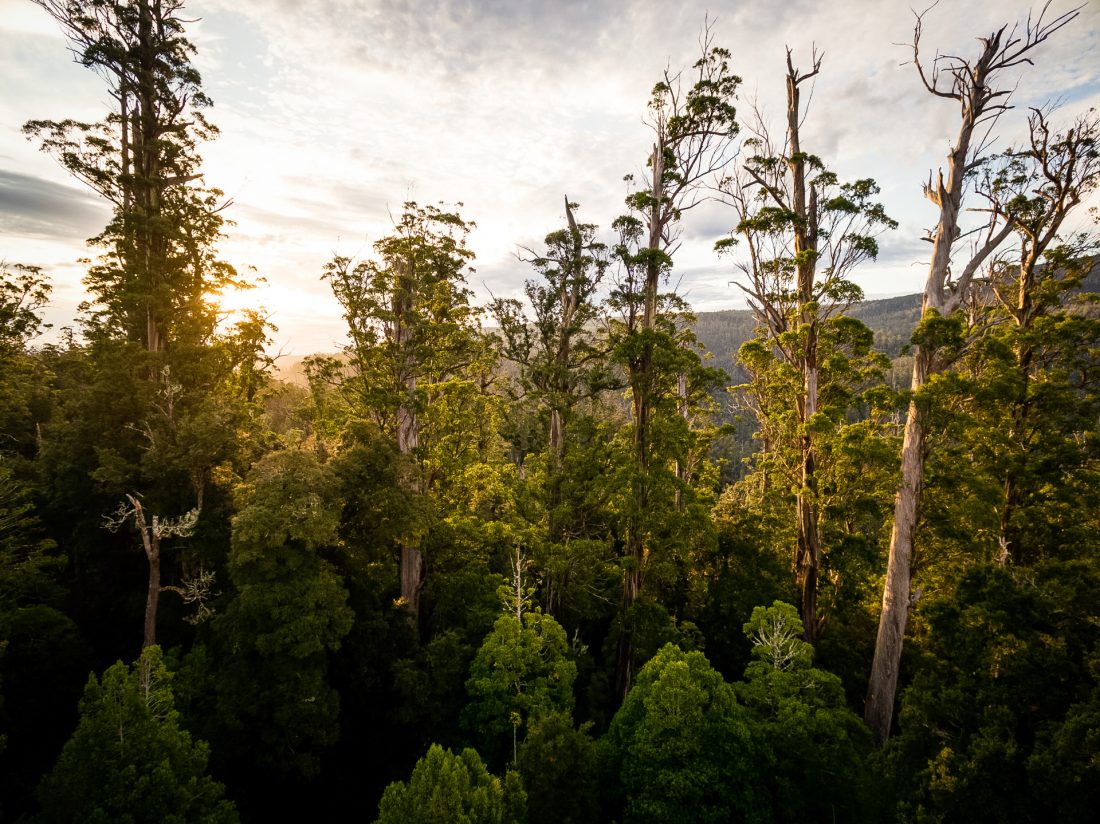
Vista over the tree tops: Tasmania’s Styx Valley is home to impressive old-growth wet eucalypt forest
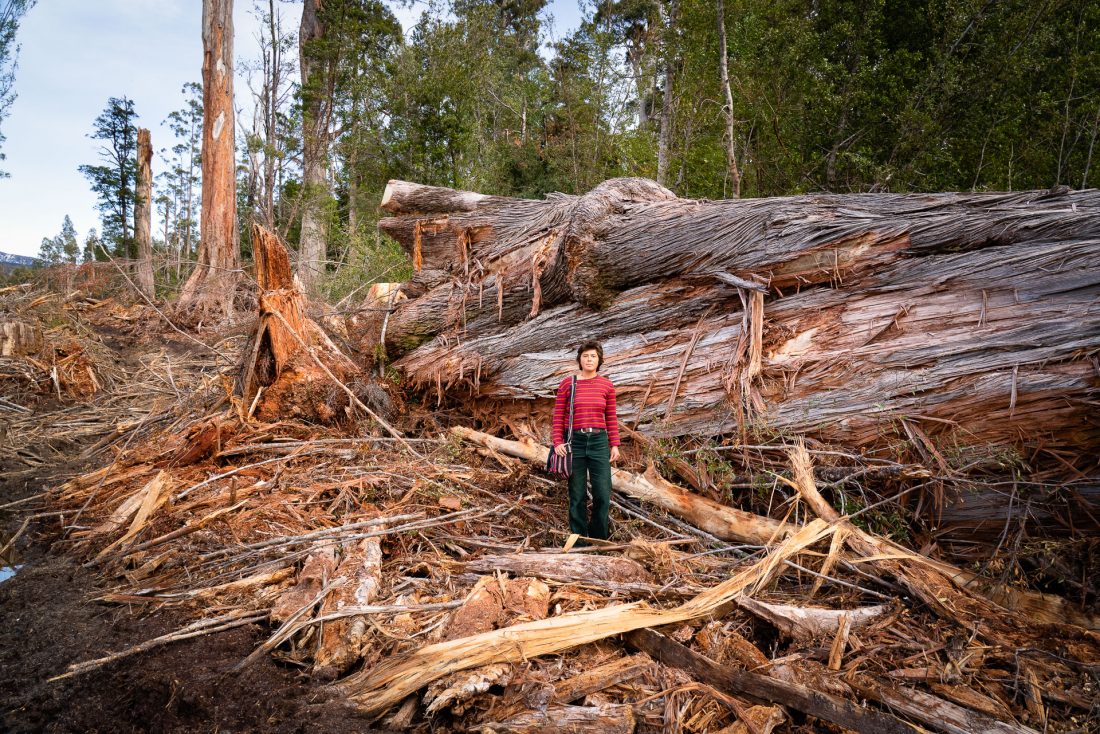
A 4.2m diameter tree felled in December, 2019. Too big for machinery to break down, it was left to rot
What makes it even worse is that it’s almost pointlessly wasteful. When loggers go in after, say, Tasmanian oak, very little ends up as prized hardwood. “Sixty percent of logged old growth forest gets burnt,” explains Carney, “and of that 40% left, 70% might end up as woodchips, with another 20% maybe used in a veneer mill.” That leaves a tiny fraction to become the Tasmanian oak sawlog that might be used in kitchens or for flooring. Whole ecosystems are being destroyed for little economic sense.
“We spend a lot of time complaining about the government. Sometimes, we need to just go out and do stuff.”
There are many groups fighting back, like the Bob Brown Foundation, the Wilderness Society and others. “The environment movement in Tassie,” says Carney, “has a really long history. And we’re really famous for direct action. But we [Forestry Watch] saw an opening for a really positive, boots-on-the-ground-style citizen science project.”
“We survey areas called coupes,” says Jen Sanger, another of Forestry Watch’s founding members, “that are scheduled for logging. We do an assessment of the area, and measure the habitat quality of these forests, because a lot of the time what we’ve found…is that the [loggers] aren’t actually doing the surveys properly. We go in and double check things.”
And that’s where tape measures come in. “Prov[ing] excellent quality habitat,” says Carney, “involves working out the average diameter at breast height of the trees in the forest. Essentially you wander through [and] do these transects that are 50m long in a big straight line, and you measure every tree five metres either side of that line. And then you do some calculations. You can determine what kind of quality habitat it is for a variety of different species—swift parrots, masked owls and other hollow-living or hollow-breeding species.”
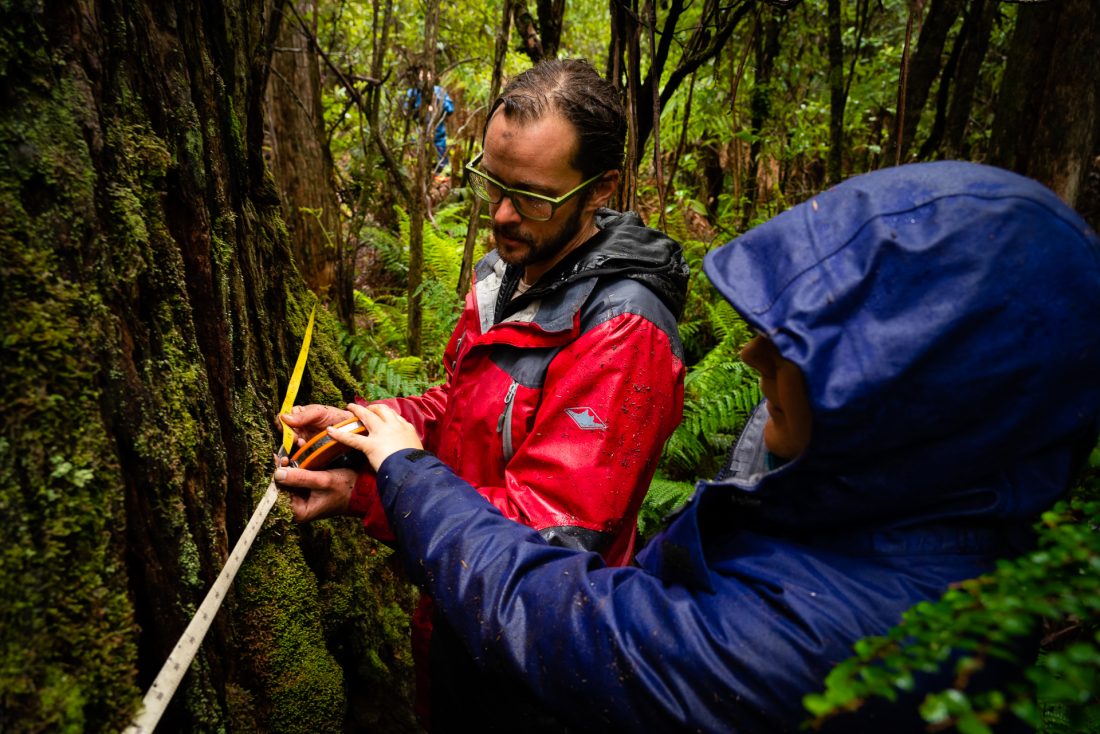
Forestry Watch volunteers measure a large tree in a forest scheduled to be logged
There is also what’s termed a “giant tree policy”; anything over 85m gets a reserve put around it. Volumetric giants—trees containing more than 280m3 of timber—are also deemed worthy of protection. Under SST’s rules, most trees over 5m in diameter (which is enormous; to put it in perspective, a tree wider than the average car is long) can also be spared. The problem is that Forestry Practices Plan assessors for SST, either wilfully or carelessly, often miss trees that qualify. Recently, says Sanger, in one coupe alone slated for logging, “[Forestry Watch] found five trees over five metres in diameter. We named each of them after climate change activists.” Great Thunberg. David Attenborough. Tim Flannery. Naomi Klein. Sunita Narain.
It can be easy to forget citizen science like this is often far more accessible than we think. It doesn’t always require formal training (though, of course, that doesn’t hurt). It can also be easy to forget that you don’t necessarily need to formally join a recognised conservation group to fight back against the behemoth logging industry. In fact, it’s possible just to get stuck in. Forestry Watch is a prime example. It’s not a formal NGO; back in November last year, a half-dozen or so like-minded people simply decided to give themselves a name, put up a Facebook page, and begin heading out into Tasmanian forests due to be logged to see what they could find, and to see who could be encouraged to come along and help.
“We spend a lot of time complaining about the government,” says Yanti Winoto-Lewin, a driving force in the formation of Forestry Watch. “Sometimes, we need to just go out and do stuff.”
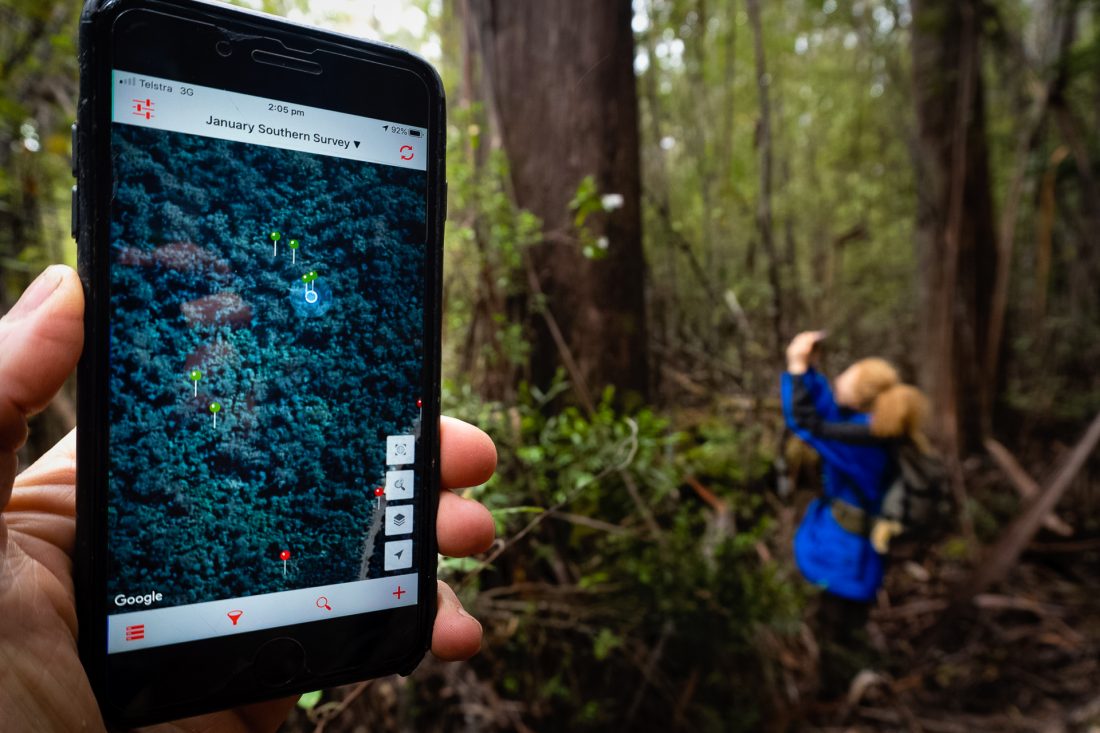
Citizen science teams use smartphone apps to record tree measurements and information about the forest
In some ways, the group’s foundation was a result of members wanting to counter the almost existential angst engendered by continual attacks upon—and the deterioration of—the environment. For Carney, the return of the federal Morrison Government in what was billed as ‘The Climate Election’ led to a sense of hopelessness. “Everyone I knew was somehow involved in that election, whether it was rallies on the street, or making phone calls, or whatever. And then when it didn’t happen, there was a big sense of like, ‘Well, shit, what do we do?’”
For Jen Sanger, a forest ecologist with a PhD in ecology, a key impetus to get involved was the 2019 fires, which began in Tasmania the summer before those on the mainland. “We live right near bush. We were constantly scared that our house was going to burn down for two months. I came out the other side of that [with] mild post-traumatic stress. And I just felt disempowered by what was happening in the world [with climate change], depressed by it, and the only way I felt I could change that was to actually do something good.”
“These stands of eucalyptus regnans are some of the most carbon dense forests in the world. A single hectare can store as carbon as that generated by a small car driving 10 million kilometres.”
Most directly, however, the group actually grew out of another informal group called Tuesday Night Nature that met weekly at the Hobart office of The Wilderness Society. Winoto-Lewin, one of the regular attendees, says “a few of us had been browsing the Forest Protection Authority [FPA]website, and looking at the regulations they had. Surely, we thought, some were being breached by Sustainable Timbers? So we went and did some surveys in a few coupes that summer.”
Notably, Winoto-Lewin, who is studying at the University of Tasmania, and Danny Carney and a few others went to Australia’s most southerly scheduled logging coupe—LU040F. The coupe, down near Lune River, has mature stands of enormous stringybarks, along with pockets of blue gums and mountain ash, and is bordered by buttongrass moorland. Eagles fly overhead, and the stringybarks offer homes for critically endangered swift parrots along with Tasmanian masked owls. On the ground, Tassie devils and quolls prowl around. “We were really enamoured by it,” says Danny Carney. The group spent 48 hours there surveying the coupe, and then released a report of their findings.
It didn’t save the whole coupe; loggers went in anyway. But they didn’t take everything; roughly a third was left unlogged. “It showed us,” says Winoto-Lewin, “that this mode of protecting forest had potential.”
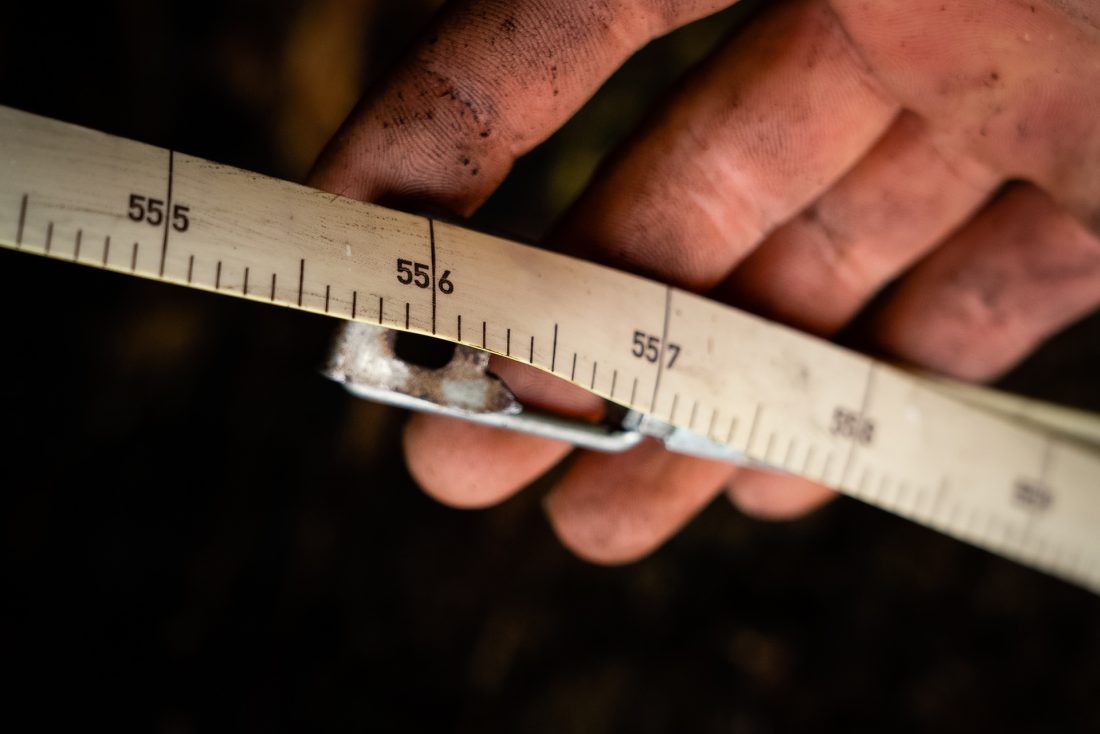
Five trees over 5m diameter not mentioned on STT’s forest practices plan were found in logging coupe AR050F
They had other groups to emulate, too. In the fight for Victoria’s East Gippsland forests (as we saw in Wild Issue #175’s story on the ‘Battle for the Southeast Forests’), surveying has had success in recent years in halting, or at least slowing, the devastation being wreaked upon this magnificent environment. Groups like GECO (Goongerah Environment Centre) and WOTCH (Wildlife Of The Central Highlands) have proved successful, using Victorian state legislation to their advantage by finding breaches of the forestry act and then forcing loggers to comply.
Although WOTCH, in particular, has provided a model to follow, that doesn’t mean it’s directly applicable. Unfortunately, compared to Victoria, says Jen Sanger, “down in Tassie our laws are a lot weaker. Our logging rules are a lot weaker.” Many gains made in Victoria, she says, just aren’t possible in Tasmania. “We’ve found a lot of stuff we consider to be breaches. We take [the breaches] to the FPA, [who] are meant to be an independent advisor. But often the response we get from the FPA is that nothing’s amiss. And that’s because the legislation in Tasmania is weak.”
There’s also the arbitrary nature of what rules do exist. For example, that giant tree rule? It only comes into play for trees that are 85m high. An 80m tree—a tree that, to put it in perspective, stands as high as a 25-storey building—sorry, that can get logged (unless it’s also a volumetric giant). The crazy thing is that the wood in those giants is usually degraded and has little economic value. Moreover, these stands of eucalyptus regnans are some of the most carbon dense forests in the world. A single hectare can store as carbon as that generated by a small car driving 10 million kilometres.
Those arbitrary rules, coupled with Tasmania’s weak legislation, can make it feel a bit like using a bucket to fight against the tide, says Sanger. “But we’re still pressing ahead with it anyway.” A large reason for that is that despite its fledgling status, surveying is proving a great tool with which to grow community involvement. While there are eight or so main organisers, each bringing separate skills (in addition to Sanger, Winoto-Lewin and Carney, there’s Carla Bruinsma, is a recent university graduate with an ecology background, Alex Wylie, a hydrologist, and Steve Pearce, a photographer and videographer) on surveying days, far more can turn up.
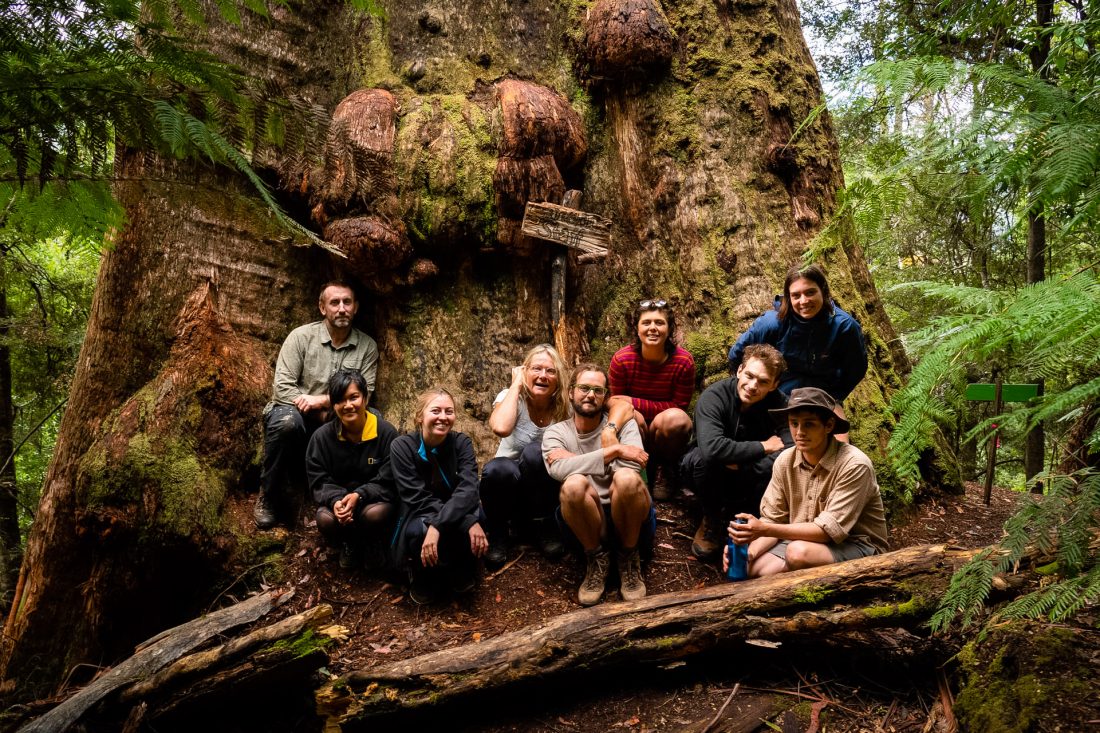
Citizen science team in the Styx Valley in March this year
Group surveying days have been taking place roughly every month or so, and numbers have been steadily growing. For the group’s most recent survey, held on July 26, they went down to a coupe called DN007B. “We had 40 people come with us,” says Carney. “They were aged between probably 12 and 80. People from China, from Kuala Lumpur, from Hong Kong, from South America, from the mainland. We had trade students, scientists, lawyers. And there was something for everyone to do. Less-able bodied people walked up and down the road staring up in the trees looking for hollows. Some wilderness bush walking guides [went] into the furthest reaches of it. It was just a wonderful day. Everywhere you looked, there was a tree with a circumference of 15m or 20m. I feel quite happy saying that was the most breathtaking, beautiful, inspiring forest have ever been in, national park or otherwise.”
But it’s not just getting more hands on deck that makes days like this important. Yanti Winoto-Lewin says it has real value in awareness-raising. “Perhaps as many as a quarter of the attendees have little or no forest experience,” she says. But by bringing people into “these absolutely amazing old growth forests, [they] see what’s at stake. They come along not knowing much, and they come away with a newfound respect for forests. They feel a connection to them, making it more likely in the future that they’ll want to protect them.”
Beyond that, though, surveying is simply pleasurable. “Measuring trees is fun,” says Yanti. “It’s exciting. That act of walking around the tree, and thinking about the numbers of it—how old it is; how much photosynthesis it’s done in its life—it makes you stop and appreciate it. And it’s all just carbon from the air. It’s crazy.”
“Sometimes it’s really similar to bushwalking,” says Carney. “You’re bushbashing, and there are no tracks. You gain this ridge or this forest or this plateau, and you sit down all sweaty. And it just feels good.” There’s a downside, though. “You’re enjoying it,” he continues. “And then it kind of dawns on you; Oh, hang on. This place might not be here next time I come back.”
CONTRIBUTOR: James McCormack is the Editor of Wild
To learn more about Forestry Watch and/or about how you can get involved, go to Facebook.com/forestrywatch. Members of the public are encouraged to join in the (roughly) monthly surveying trips.


